| Kingdom of Mewar | |
|---|---|
| 566–1949 | |
 Flag
Flag
 Coat of arms
Coat of arms
| |
| Motto: "The Almighty protects the one who upholds righteousness" | |
 The Kingdom of Mewar at its greatest extent c. 1521 The Kingdom of Mewar at its greatest extent c. 1521
| |
 The Udaipur State in 1909 within the Rajputana Agency The Udaipur State in 1909 within the Rajputana Agency | |
| Capital | |
| Common languages | Mewari |
| Religion | Hinduism |
| Government |
|
| Maharana | |
| • 566-586 | Rawal Guhil |
| • 728-764 | Bappa Rawal |
| • 1326-1364 | Hammir Singh |
| • 1508-1528 | Rana Sanga |
| • 1572-1597 | Maharana Pratap |
| • 1930-1948 | Bhupal Singh |
| History | |
| • Established | 566 |
| • Accession to the Union of India | 1949 |
| Area | |
| 1901 | 33,030 km (12,750 sq mi) |
| 1941 | 33,517 km (12,941 sq mi) |
| Population | |
| • 1941 | 1,926,698 |
| Today part of | India Pakistan |
The Kingdom of Mewar was an independent Hindu kingdom that existed in the Rajputana region of the Indian subcontinent and later became a dominant state in medieval India. The kingdom was initially founded and ruled by the Guhila dynasty followed by the Sisodiya Dynasty.
The earliest kingdom was centered around the south-central part of Rajasthan, state of India. It was bordered by the Aravali Range to the northwest, Ajmer to the north, Gujarat, Vagad and Malwa regions to the south and the Hadoti region to the east.
Mewar rose to prominence in the reign of Bappa Rawal(7th Century A.D.) known for his involvement in thwarting Arab incursions in India. Over time, It became vassal to Imperial Pratihar, Parmars and then to Chauhans. In the early 10th century, Mewar emerged as an independent state, actively battling neighboring powers and confronting the expansion of Delhi Sultanate until the fall of its capital Chittorgarh in 1303 against the latter, leading to the annihilation of Guhila Dynasty.
The Sisodia dynasty junior branch of Guhilas re-occupied Mewar in 1326, ushering in a golden age characterized by military prowess and territorial expansion. Under the reigns of Maharana Kumbha and his grandson Maharana Sanga, Mewar achieved victories against Islamic States of Malwa, Gujarat and Delhi particularly in Mewar-Malwa conflicts and Mewar- Delhi conflicts. It also successfully fought off and vassalized neighboring Hindu kingdoms. At its zenith, it controlled large parts of Northern India. The kingdom faced decline following Maharana Sanga's death. However, it continued to resist Mughal expansion, most notably under Maharana Pratap. Though it later became a vassal state with significant degree of autonomy. Sovereign leaders like Raj Singh and his successors led rebellions culminating in de facto independence for Mewar, notably Rathore Rebellion and Rajput- Mughal war(1708-1710). Eventually, falling under Maratha Confederacy's influence and accepting British suzerainty in 1818, Mewar remained a princely state until it joined the Union of India in 1947.
Mewar's legacy includes its prolonged resistance against the Islamic invasion and traditions like Jauhar (self-immolation) witnessed during the time of defeats. The Kingdom, primarily a Hindu state, patronized Jainism and Buddhism. Among the Mewar's, UNESCO World Heritage Sites are Kumbhalgarh and Chittorgarh, described variously as the jewels of Rajput architect in India. Udaipur, also known as the city of lakes and one of the largest cities of the North India was also founded by the Rana of Mewar, Udai Singh II.
Geography
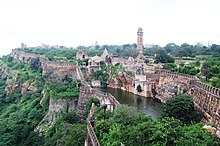
Mewar is surrounded by the Aravali Range to the northwest, Ajmer to the north, and Gujarat, Vagad, and Malwa to the south, with the Hadoti region to the east. The area features mountainous hills, plateaus, and rivers such as Banas, Som, and Sabarmati, along with dry deciduous forests that are denser during the monsoon months. The central plains, watered by the Banas River and its tributaries, are highly cultivated, with black, light loamy soil supporting crops like cotton, maize, sugarcane, wheat, and barley, suitable for both Kharif and Rabi seasons. The average height of these plains is about 600 ft. MSL. This geography has allowed Mewar to maintain its freedom and resist imperial powers, making it favourable for guerrilla warfare. The boundaries of Mewar largely remained consistent except from 1326 to 1533, during which time the kingdom more or less extended from near Mandu(capital of Malwa Sultanate) in the south to Bayana in the north-east, reaching into desert areas towards the Indus River in the west. Thus, controlling large parts of Northern India. However, due to dynastic conflicts and ongoing struggles against the Mughals and Marathas, the kingdom's size diminished, eventually covering an area of 14,000 square kilometers by 1941. With the treaty of Accession to India, the area of Mewar was merged with the Rajasthan.
Early History and Legend
Main article: Guhila dynasty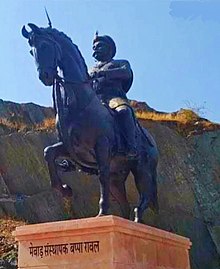
Less is known about the origins of the Kingdom of Mewar. It was originally ruled by the Guhila dynasty. Guhadatta is considered the first ruler of the kingdom in the 7th century. In the early 8th century, it came under the sub ordinance of the regional Mori rulers. The kingdom under Bappa Rawal acquired control of Chittor in 728 after taking it away from its Mori overlords. Nagda was the capital of Mewar around this period. Bappa Rawal defeated an early Arab Caliphate invasion of India through a confederation with Gurjar-Pratihara ruler Nagabhata I. Bappa Rawals successors, namely Khuman II would continue to resist Arab incursions into the country.
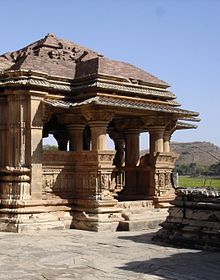
The Guhilas from the 8th century acknowledged the suzerainty of the Gurjara-Pratiharas. In the 10th century, Bharttripatta II became an independent ruler and broke ties with the Pratihara empire and assumed the title Maharajadhiraja. His successor Allata killed Devapala, the ruler of the Gurjara Pratihara at that time.
The Guhilas was controlled by the Kingdom of Malwa in the 11th century and by the Chahamanas in the 12th century. Guhila ruler Samantsingh established another branch of Guhilas in Vagad and also fought alongside the defeated Prithviraja III of Ajmer in Second Battle of Tarain against Muizzuddin Muhammad Ghuri.
Through the 13th century, the Guhilas started getting more powerful and became independent of the Chahamana rule. It had to resist multiple invasions by Turkic invaders. Eventually, in 1303 Sultan of Delhi, Alauddin Khalji invaded Mewar, besieged Chittor. In the siege, Rana Lakhan with his seven sons died in the battle and the women committed Jauhar. Although, Ajay Singh survived the disaster who later brought up Hammir.
Reestablishment as Sisodia Kingdom
See also: Mewar–Malwa conflicts
Early Expansion and consolidation
Following Alauddin Khalji's invasion in 1303, Guhila Dynasty was killed. In 1326, Hammir Singh, a descendant of Rahapa, from Sisodiya dynasty(junior branch of Guhilas )attempted to regain control of Mewar, but his initial efforts were thwarted. Khizr Khan, one of Alauddin's sons, was forced to relocate, and Maldev Songara from the Chauhan clan took charge of Mewar, successfully repelling Hammir’s assaults. Eventually, Hammir seized the fort of Jilwara and established a base in Kelwara, allowing him to capture further territories, including Sirohi and Idar.
Hammir later recaptured Chittorgarh and defeated the imperial Delhi Sultanate force's at the Battle of Singoli.
Rana Kshetra Singh (1364-1382), expanded the kingdom significantly, capturing Ajmer, Hadoti and Mandalgarh. He also quelled a rebellion in Idar alongside defeating Dilawar Khan of the Malwa Sultanate. Kshetra was succeeded by Lakha, who conquered Merwara and helped Rao Ranmal Rathore, one of the princesses of the neighbouring Kingdom of Marwar, to gain the throne, thus establishing Mewar's influence over Marwar. He also rebuilt Mewar’s infrastructure, destroyed during the invasion of Allaudin Khalji, but died in battle to secure pilgrimage taxes. It was during his reign that his elder son Chunda abdicated the throne for his younger brother Mokal, son of the second wife of Lakha and a Rathore princess, over a dispute.
Lakha's son Mokal Singh became Rana at a young age under the regency of his mother, Hansa Bai. He successfully defended against invasions, annexed Ajmer and Sambhar, and conquered Jalore before being assassinated by his uncles.
Maharana Kumbha
Main article: Kumbha of Mewar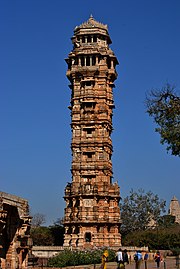
After his father's assassination, Rana Kumbha ascended to the throne in 1433. He first dealt with this father's assassins and killed them. by the support of King of Marwar Rao Ranmal Rathore whom his father had helped to become the king. As one of the assassins of Mokal, Mahpa Panwar, was sheltered by the Sultan of Mandu, a demand for his person was made by the Maharana, but Mahmud Khilji refused to surrender the refugee. The Maharana prepared for hostilities and advanced to attack Mandu. The Sultan advanced with a powerful army to meet Kumbha. After a severe engagement the sultan's army was defeated and sultan was forced to fled to the fort of Mandu, following the victory Rana Kumbha laid siege to the fort of Mandu and captured the sultan, who was later freed. Rana captured the areas of Gagron, Ranthambore Sarangpur, Durganpur, Banswara and Raisen from the Malwa Sultanate. He also annexed region of Hadoti. Due to the growing power of Ranmal, Rana had Ranmal assassinated and Rana Kumbha captured Marwar too. In coming years Sultan made several attempts to revenge his defeats in the battle of Mandalgarh and Banas but every time he was defeated. Rana Kumbha started the conquest of Nagore due the harsh treatment of Hindus there. Shams Khan son of suptan of Nagore fled to Maharana Kumbha for shelter and help. Rana Kumbha who had long designs on Nagaur, gladly embraced this opportunity of carrying them out, and agreed to place Shams Khan on the throne of Nagaur on the condition that he acknowledged Rana Kumbha's supremacy by demolishing a part of the battlements of the fort of that place. Shams Khan accepted the terms.Rana Kumbha marched with a large army to Nagaur, defeated Mujahid, who fled towards Gujarat, and placed Shams Khan on the throne of Nagaur, and demanded of him the fulfillment of the condition. But Shams Khan humbly prayed to the Maharana to spare the fort, for otherwise his nobles would kill him after the Maharana was gone. He promised to demolish the battlements himself later on. The Maharana granted this prayer and returned to Mewar.
No sooner, however, had Rana Kumbha reached Kumbalgarh when he got the news that Shams Khan instead of demolishing, began to strengthen the fortification of Nagaur. This brought Kumbha on the scene again with a large army. Shams Khan was driven out of Nagaur, which passed into Kumbha's possession. The Maharana now demolished the fortification of Nagaur and thus carried out his long-cherished design. With the conquest of Nagore areas of Janglaudesha and Sapdalpaksha also came under him. Shams Khan fled to Ahmedabad, taking with him his daughter, whom he married to Sultan Qutb-ud-din Ahmad Shah II. The Sultan thereupon espoused his cause and sent a large army under Rai Ram Chandra and Malik Gadday to take back Nagaur. Rana Kumbha allowed the army to approach Nagaur, when he came out, and after a severe engagement, inflicted a crushing defeat on the Gujarat Sultanate army, annihilating it. Only remnants of it reached Ahmedabad, to carry the news of the disaster to the Sultan. The Sultan now took the field in person, determined to wrest Nagor back from the Maharana. The Maharana advanced to meet him and came to Mount Abu. In S. 1513 (A.D. 1456) the Sultan of Gujrat "despairing of reducing Chitor" arrived near Abu and sent his Commander-in-Chief, Malik Shaaban Imad-ul-Mulk, with a large army, to take the fort of Abu, and himself marched upon the fortress of Kumbhalgarh. Kumbha, aware of this plan, came out, attacked and "defeated Imad-ul-Mulk with great slaughter," and He by forced marched Kumbhalgarh before the Sultan arrived there. He also conquered regions of Abu and Sirohi. After getting repeatedly defeated by Kumbha Sultans of Gujrat, Malwa and Nagor prepared to take joint actions against Mewar and divide the spoils. Sultan of Gujrat move towards Kumbalgarh but was defeated there. Nagor was also defeated. Sultan of Malwa took Mewar territories up to Ajmer but after seeing defeats of sultans of Gujrat and Nagor allowed Rana Kumbha to recapture his lost territories.
Maharana Raimal
He came to power by defeating his patricide predecessor, Udai Singh I in battles at Jawar, Darimpur and Pangarh. Early in Raimal's reign, Ghiyas Shah of Malwa attacked Chittor unsuccessfully. Soon after, Ghiyas Shah's general, Zafar Khan attacked Mewar and was defeated at Mandalgarh and Khairabad. By marrying Sringardevi (daughter of Rao Jodha), Raimal ended the conflict with the Rathores. During Raimal's reign, Godwar, Toda and Ajmer were captured by his son Prithviraj. Raimal also strengthened the state of Mewar and repaired the temple of Eklingji in Chittor.
Maharana Sanga
Main article: Rana SangaAfter his father's death, Sangram Singh ascended on the throne in 1509. Around 1517, in the Sultanate of Malwa under the Sultan Mahmud Khilji II, too much power landed in the hands of Medini Rai which upset a lot of Muslim nobles. Eventually, Mahmud himself asked for help from the Sultan of Gujarat to get rid of Medini Rai. The war started as the two sultans besieged Mandu where Rai's son died. Sanga supported Medini Rai and in turn attacked and captured Gagron where he appointed Medini Rai to govern as a replacement to his prior holdings in Malwa.
Main articles: Battle of Khatoli and Battle of DholpurIn 1518, Ibrahim Lodhi ascended to the throne of Delhi. He engaged with Sanga in two major battles when he realized Sanga had been encroaching on land in the Sultanate. The sultan was defeated at Khatoli and Dholpur; as a result, Sanga was able to capture the entire North-East Rajputana up to Chanderi. This defeat was a humiliating setback for the new sultan as he lost much territory to an internal conflict in his empire. In the Battle of Khatoli, a sword injured Sanga's arm, and his leg was injured by an arrow, making him lame.
In 1518 Mahmud Khilji II collected another massive army and invaded Mewar through Gagron. In the ensuing battle, the Maharana won decisively; he took Khilji captive, appointed a physician to care for Khilji, and later escorted him back to his kingdom to Mandu. In 1520, Sangram decided to attack Idar and the Sultanate of Gujarat after a furious exchange with him. In the ensuing campaign, the Rana not only completely captured Idar, but also raided Ahmadabad and returned with massive wealth looted.
After looting Ahmadnagar, the Sultan of Malwa and Gujarat mobilized heavily in 1521 against the Rana, who joined forces with the entire Rajputana. In the end, the heavy mobilization was of no use, and Sanga could use his brilliant diplomatic skills to scare the Sultana. The same year, Ibrahim Lodhi tried to attack the Rana but failed again. It is around this time that Sanga's power is at its zenith. He had thoroughly defeated Gujarat and Delhi, largely captured Malwa, and allied with the remaining parts of Rajputana.
In 1526, Babur invaded, defeated and killed Ibrahim Lodhi. Thus, the foundation of the Mughal Empire is from the Lodhi Empire's remains. After successful skirmishes and defeating Mughal forces in Bayana, Sanga suffered a serious reverse despite the numerical superiority because of the use of Gunpowder by the Mughals. He was wounded in battle and was removed in an unconscious state by Prithviraj Kachwaha of Amber and Maldeo Rathore of Marwar. His generals eventually poisoned him for not leaving a desire to defeat Babur after being defeated in Khanwa.
After Sangram's death, his son Ratan Singh II was placed on the throne by the generals. Mahmud Khilji, whom Sangram badly defeated, tried to cash the opportunity of a week Rana and invaded but was badly defeated and was also defeated in a counterattack. In 1531, he was killed in battle. His brother Rana Vikramaditya succeeded him at a young age, and was unpopular. During his reign, Mewar was invaded by Bahadur Shah of Gujarat. His cousin Vanvir Singh Kelwa assassinated Mewar, usurped the throne in 1534, and kept it for six years. Vanvir also attempted to kill Vikramaditya's brother Udai. However, Udai's nurse Panna Dhai placed her son in Udai's bed, getting him killed and saving the heir to the throne.
In 1540, an older Udai took over Chittor and let Vanvir walk away. He became Udai Singh II.
Decline and Struggle against Mughals
Main articles: Siege of Chittorgarh (1567–1568), Battle of Haldighati, and Battle of Dewair (1582)Udai Singh II
Main article: Udai Singh II

Early into his reign, Maldev Rathore unsuccessfully invaded Mewar. In 1557, he was defeated by a joint invasion by Haji Khan and Maldeo Rathore in the Battle of Haramada. He is most known for establishing the city of Udaipur. The city was designed with the use of gunpowder by Persian invaders in India. He settled people in the city and constructed forts as well.
During his reign, Akbar, Babur's grandson, made great efforts to get the Maharana to accept his suzerainty by sending emissaries and envoys. When Udai Singh rejected all offers, Akbar considered invading Mewar. Udai Singh had faith in his forts as they had defended the rulers for decades in the past and were very strong. He was advised by his generals to make adequate arrangements for defence and then retire to the hilly areas of Chittor, which he heeded.
Siege of Chittor (1567)
Main article: Siege of Chittorgarh (1567–1568)Akbar laid siege to the fort of Chittor and started making direct attacks. When these attacks failed to do any damage, he ordered construction of sabats (approach trenches). The Rajput defenses showered the constructors of these sabats with arrows and cannonballs but eventually the sabats' construction was complete. Explosives were set on these sabats for breaching the sturdy Chittor walls and explosions were able to break some walls but the Rajputs quickly filled those cavities. The explosions killed hundreds of Mughal soldiers and threw rocks miles away and was heard in towns very distant. Several other sabats were built in front of other walls. These explosions disheartened many Mughal soldiers and Akbar himself but the siege kept going. While fighting, Jaimal Rathore, the commander of Mewari forces was shot dead by Akbar, soon after which the doors of Chittor were breached and Hindu soldiers fought to death. Women of the fort committed Jauhar. Soon the fort was taken over and Akbar commanded a slaughter of around 30,000 inhabitants of the fort. Udai Singh II died 4 years later in 1572.
Maharana Pratap Singh
Main article: Maharana Pratap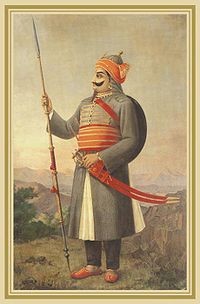
Udai wanted his second son Jagmal to succeed him, but after his death, his eldest son, Pratap was enthroned by the generals. The order of damage inflicted by Mughal forces in 1568 to Chittor meant that Pratap was not willing to make any concessions to Akbar. He saw Mughals as invaders who were resisted by his father and grandfather. Within 1 year, diplomatic missions by top Mughal officials like Man Singh, Bhagwant Das, Todar Mal failed to convince Pratap to accept Mughal dominance, appear in Mughal court, pay tribute and enlist as a Mansabdar.
Battle of Haldighati
Main articles: Battle of Haldighati and Battle of dewair 1582Pratap soon started to prepare for a big battle. He retired from his fortress until Chittor was recaptured, forbade the use of silver and gold in the kingdom, and forbade sowing of crops to prevent Mughal forces from acquiring supplies from his own land. The big battle came in the form of the Battle of Haldighati with Akbar sending Man Singh against the forces of Mewar headed by Pratap.
Pratap first attacked on the center wing of the army which forced Mughals to retreat. Mewar army was also able to break the left and right wing of the Mughal Army. It was appearing that Mewar would win but slowly Mewari army started getting exhausted and Mihtar Khan on the Mughal side started beating the kettle-drums and spread a rumour about the arrival of the Emperor's army reinforcements, which raised the morale of the Mughal army and turned the battle in their favour. The Mewari soldiers starting deserting in large numbers, finding the day lost and eventually Pratap was injured and had to leave the battlefield. A Jhala chieftain called Man Singh took the Rana's place and donned some of his royal emblems by which the Mughals mistook him for the Rana. Man Singh Jhala was eventually killed, however his act of bravery gave the Rana enough time to safely retreat.
Next year in 1577, Akbar's forces under Shahbaz Khan attacked the fort of Kumbhalgarh, one of the most important forts for the Rajputs. During the fierce siege, Pratap had to leave the fort to his generals who defended it till April 1578 and lost to the Mughals after a heavy fight. After the fall of Kumbhalgarh, Pratap was chased by Shahbaz khan for several years, trying to capture him but he escaped multiple times. It was later through his general Bhamashah's help, that he was able to replenish his army.
Battle of Dewair
After a few years preparations, Prataps son prince Amar was able to defeat Mughal Commander Sultan Ghori at the Battle of Dewair in 1582 and Kumbhalgarh was taken by Pratap from Abdullah Khan in 1583. Over the next few years, Akbars pursuit for Pratap loosened and he started focusing on his own empire. Pratap was able to capture all important forts in Mewar except Chittorgarh and Mandalgarh which remained under his reign for the rest of his life. He died in 1597.
Amar Singh
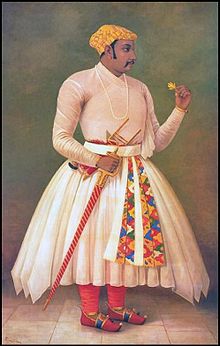
Pratap's 38-year-old son Amar succeeded him. In 1600, his kingdom was invaded by Akbar's son Salim in which Mughals were defeated and their top generals like Sultan Khan Ghori were killed. Akbar tried to make another attempt to invade Mewar in 1605 but the invasion was cut short by his death. After Akbar, his son Salim succeeded as Jahangir and sent a large force under his son Parviz to invade Mewar. To defend against Parviz, Amar built a new capital at Chawand, a hilly location in Mewar. Then preparations were made to defend against the Mughals. In 1606, in the Battle of Diwair, Mughals were badly defeated. During this time, Amar' son Sagar defected from Rajputs to Mughals and was appointed at Chittor by Jahangir. In 1608, a massive army under Mahabat Khan was sent to Mewar through Mandal and Chittor. This army was badly defeated and had to retreat because of continuous raids by Rajput forces. In 1609, Mahabat Khan was replaced with Abdullah Khan who was able to defeat Mewar in several battles from 1609 to 1611. In an attack by Abdullah Khan, Amar Singh was forced to abandon the capital of Chawand.
The Mughals continued to chase the Maharana for several years but no one was able to capture the Rana. After this, in 1613, Jahangir himself came to Rajputana to supervise the campaign. His son Khurram led the campaign on the ground. Rajputs were easily able to seek refuge in the hilly tracks of Rajputana and the Mughals largely failed to penetrate it. They were finally able to penetrate it in 1614 when they engaged with Mewar forces and established outposts. Many attempts were made by Jahangir to make settlements with the Maharana and the final attempt in 1615 succeeded when Amar Singh agreed to meet with Prince Khurram.
Treaty with Mughals
In February 1615, Khurram and Amar Singh met in Gogundah. Tributes were exchanged between the Maharana and the Prince. Following terms were accepted by both the parties.
- Maharana's eldest son would serve under the Emperor.
- Maharana would provide a 1000 horsemen contingent in the Mughal Army.
- Maharana would never try to return to Chittorgarh.
Ranks were provided to Maharana's heir Karan. Other official honors and ranks were also exchanged. Jahangir got marble statues of Amar and Karan Singh constructed in Deccan and installed in a garden in Agra.
Throughout the rest of his life, Amar spent time in Udaipur, making administrative reforms to his kingdom and restoring it. He died in 1620 at the age of 60.
Mewar in the Later Mughal Period
Main articles: Rathore rebellion (1679–1707) and Rajput Rebellion (1708–1710)Karan succeeded his father Amar in 1620. He reformed his kingdom and repaired several temples including the Ranakpur Jain temple damaged by Mughal commanders. Karan also helped prince Khurram and gave him refuge when he had rebelled against his father in 1623. Karan also supported Mahabat Khan, who rebelled against Jahangir. Khurram stayed for 4 months and exchanged turbans with the Maharana which is still stored in Pratap Museum. When Jahangir died in 1627, Khurram passed through Mewar and met with Karan again. Khurram was crowned the Mughal emperor as Shah Jahan. Karan died 2 months later.
After Karan's death, his son Jagat succeeded him in 1628. He was sent a robe of honor by Shah Jahan. Jagat invaded Dungarpur because it enlisted itself in the Mughal Mansabdari system. In the resulting war, Dungarpur lost and its ruler was killed. He get the famous Jag Mandir constructed during his reign.
Spoiled relations with Mughals
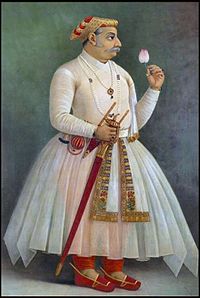
Jagat Singh died after a 24 year long reign and was succeeded by his son Raj. Towards the end of Jagat's reign, Mughal-Mewar relations had been strained. Shah Jahan sent a robe of honor for Raj Singh as well but the relations could not be restored. Raj continued making restorations to the Chittor fort, going against the Mughal-Mewar treaty of 1615. Maharana had constructed walls around the fort and had reduced the contingent size given to the Mughals. Maharana then sent a diplomatic mission to the Mughals to settle the issue. But eventually Shah Jahan ordered his son Aurangzeb and grandson Mahmud to invade Chittor and demolish the new wall in 1654. Eventually Shah Jahan withdrew Mughal forces and letters of settlement and assurances were exchanged.
War of succession
In 1658, the Mughal war of succession was going on and Raj Singh took an advantage and invaded the Mughals and successfully loot and plunder in adjacent areas. Throughout the war, Raj Singh remained neutral among the fighting brothers but he disliked Dara Shikoh and liked Aurangzeb. He maintained contact and good relations with Prince Aurangzeb and sent his emissaries when Aurangzeb won the war of succession. After the war of succession, Raj Singh was able to win the favor of Aurangzeb and was awarded territories of Mandal and Bansawara and he was granted ranks.
In 1658, Raj Singh embarked on his own expeditions using pretence of a ceremonial "Tikadaur", traditionally taken in enemy land. The Maharana swooped down on various Mughal posts in 1658. Levies were imposed on outposts and tracts like Mandal, Banera, Shahpura, Sawar, Jahazpur, Phulia etc. which were then under Mughal control, and some areas were annexed. He next attacked pargana of Malpura, Tonk, Chatsu, Lalsot and Sambhar. He expanded the Mewar kingdom to bigger heights than before.

Mughal Mewar relations worsened further when in 1660, Raj Singh eloped with Charumati, who was going to be married to Aurangzeb. This was seen as a hostile act and several territories were confiscated from Mewar. Attempts were made to stop this confiscation but were ultimately failed. He later also participated in Rajput War (1679–1707) and defeated Mughals.
Oppressions of Hindus
When in the 1660s, Aurangzeb ordered demolitions of several important Hindu temples, Raj Singh made several efforts to secure safety of Hindu Symbols. Famous symbols rescued include the Shrinathji installed in Nathawada in Udaipur in 1662. In 1679, when Jaziya was imposed on non-Muslims in the Mughal empire, Raj Singh possibly protested against Aurangzeb by writing him a letter. Such events further spoiled relations with the Mughal emperor. During this period, Maharana continued to raid and loot adjacent territories.
Rajput-Mughal war 1679 - 1707

During the 1670s, Aurangzeb was engaging with his rivals, the Rathores. In 1679, Raj granted 12 villages to Ajit Singh Rathore. Aurangzeb begged Raj to remain loyal to him and not support Ajit, but this was not heeded by Raj Singh.
Aurangzeb sent multiple of his generals to fight with the Rana but Raj Singh defeated all of them and then Aurangzeb himself came down to the battleground. On the suggestion of his war council, Raj depopulated Udaipur and abandoned the city. In January 1680, Mughals reached Udaipur and damaged the city heavily. A major force of Mughals under Hasan Ali Khan was defeated at Nainwara. Finding it difficult to defeat Rajputs in hilly tracks, Aurangzeb left Udaipur in 1680. Raj Singh carried out sudden raids on Mughal and Malwa forces keeping them terrified. Such raids often created heavy disruption in Mughal forces.
At the height of the Rajput-Mughal war in 1680, Raj Singh died, possibly due to poisoning by Aurangzeb loyalists or by illness and fever. He was succeeded by his son Jai Singh. Under Jai, sudden attacks on Mughals continued. Mughal forces under Dilair Khan were defeated by Mewar in the same year.
Raj had made attempts to sponsor a rebellion in the Mughal empire by tempting Aurangzeb's son Akbar. His attempt was cut short by his death, but was successfully carried out by Jai in 1681. Aurangzeb overcame this by writing a false letter to his son telling him to continue deceitful collaboration with Rajputs in order to destroy them. This was intercepted by Rajputs who were tricked into believing that Akbar's alliance with them was a hoax and distanced themselves with him. Soon, in the same year, Aurangzeb was able to strike a settlement with Jai through his son Muhammad Azam to prevent the Akbar's rebellion to grow big. In 1681, Jai Singh agreed to pay Jaziya, send a contingent to the deccan under the Mughals and they were granted several territories in adjacent regions in a meeting with Muhammad Azam. Following the settlement, ranks and honors were exchanged. Jai Singh wasn't handed the possession of the granted territories and over the next one decade, he would penalize the emperor by stopping the payment of Jaziya and the Aurangzeb would penalize him for defaulting on Jaziya in other instances by taking away other territories.
Jai died in 1698 and his son Amar Singh II succeeded him in 1699. In 1699, right after Amar Singh II ascended to the throne, he invaded Durganpur, Bansawara and Devaliya. Rulers of these regions appealed to Mughal court for justice but in most cases, Maharana prevailed.
In 1707, Aurangzeb died and his sons started the war of succession. During this war, Amar supported Prince Muazzam who later won the war and was crowned Bahadur Shah I. Taking advantage of the war, Amar also captured the granted cities that were under Mughal control like Pur, Mandal and Shahpura.
Triple alliance against the Mughals

After the war of succession, Bahadur Shah I tried to get hold of the states of Amber and Marwar. These states had captured significant territories after Aurangzeb's death in 1707. Bahadur Shah was able to take the Marwar state without any resistance but had to take Jodhpur and the Amber state with force. He then chased Amar Singh II into Mewar territory. Amar Singh made a matrimonial alliance with Sawai Jai Singh of Amber by marrying his daughter Chandrakumari with him. Amar Singh, Ajit Singh and Jai Singh made a triple alliance to take back Amber and Marwar. The combined Rajput forces of the alliance attempted to capture Amber in 1708 but failed. They also attempted to capture Jodhpur and succeeded.
Battle of Sambhar
Soon, the battle of Sambhar was fought in which major Mughal commanders were killed and Rajputs won. Pur and Mandal were recaptured by Mewar. As a result of this battle, states of Amber and Marwar were restored but the rulers were posted in Gujarat and Kabul which they denied to follow.
Soon after the settlement, in 1709, Ajit Singh, Jai Singh and Amar Singh started to prepare for a large war with the Mughals with 70,000 cavalry to quell their deployments in Gujarat and Kabul. Bahadur Shah tried to persuade them to not start a war and at the height of negotiations, Amar Singh II died. He was succeeded by his son Sangram Singh II.
Battle with Ranabaaz Khan
Right after coronation of Sangram II, Bahadur Shah granted the territories of Mandal and Pur to one Ranabaaz Khan Mewati. Sangram did not give the possession of these territories to Mewati which lead to the Battle of Bandanwara in 1711. In the resulting battle, Mewati was killed and Sangram retained Mandal and Pur. Any retaliatory action by Bahadur Shah I were cut short by his death in 1712.
Soon, a war of succession broke between the sons of Bahadur Shah and eventually the only surviving son, Jahandar Shah became Emperor but only for 8 months, and was defeated and killed by his cousin Farrukhsiyar with the help of the Sayyid Brothers.
Decline of Mughal Empire
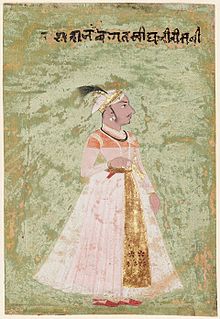
Soon, Sangram made good relations with Farrukhsiyar and honors were exchanged per the traditions. Sangram extracted heavy tributes from these rulers. He was also allowed to mint his own coins in 1713.
Maratha influence
Resistance
Starting from 1711, during Sangram's reign, the Marathas started raiding into the Rajputana in the states of Dungarpur, Banswara, and Bundi. They were driven off in their first attempts. Several attempts to form united fronts against such raids throughout 1710s and 1720s failed. Sangram II died in 1734 and was succeeded by his son Jagat Singh II. To counter the Marathas, Maharana Jagat Singh of Mewar convened a conference of Rajput rulers in Hurda in 1734, but no agreement materialised. In 1735, Mughals tried to defend against the Maratha penetration by sending a force under Qamar uddin but failed and Marathas reached Jaipur.
Subordinance
Peshwa Baji Rao I attempted to persuade Jagat to settle terms of Chauth, a tributary tax but such attempts failed. However, Jagat continued to pay a sum of money equivalent to the revenue of one territory to Holkars, the province of Marathas. In February 1736, the Peshwa arranged a friendly visit to Maharana Jagat and met him at Udaipur. During this meeting, he was able to secure chauth from the Maharana. Hence friendly relations were established between Marathas and Mewar. With the help of the Holkars, Jagat was able to secure the throne of Jaipur for his relative Madho Singh. In 1750, Ishwari Singh, the other contender for the throne committed suicide under the financial pressure by the Marathas and Madho Singh was able to capture the throne completely. Madho was able to stay afloat because of heavy investment by Jagat Singh.
Financial devastation

Jagat Singh died in 1751 and his imprisoned son Pratap but he could rule only for 3 years and died in 1754 and was succeeded by his young son Raj. During his rule, Maratha's continuous and increasing demand for tribute financially destroyed Mewar. Raj could only rule for 7 years and died without an heir. Such financial devastation continued under his uncle Ari's rule, under whom, Mewar was raided by the Marathas many times from 1761 to 1773.
After Ari's death in 1773, his underaged son Hamir became the Maharana and under him, a lot of power rested in the hands of his mother Sadar Kanwar and her trusted assistant Ram Pyari. Hammir died in 1778 and was succeeded by his brother Bhim. During Bhim's reign, Mewar was raided multiple times by the Pindaris, an unregulated military.
War over Bhim Singh's daughter
Bhim Singh's daughter Krishna Kumari was initially engaged to Maharaja Bhim Singh of Marwar but then Maharana Bhim's wife, a Jaipur princess, suggested Krishna to be married to Jaipur ruler Sawai Jagat Singh.
British influence
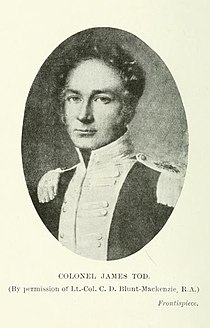
By 1818, the armies of Holkar, Scindia, and Tonk had plundered Mewar, pauperising Bhim Singh. As early as 1805, Maharana Bhim Singh of Mewar approached the East India Company (EIC) for assistance but the Treaty of 1803 with Scindia prevented the British from entertaining the request. But by 1817, the British too were anxious to have alliances with Rajput rulers and the Treaty of Friendship, Alliances and Unity was concluded between Mewar and EIC on 13 January 1818.
After the Third Anglo-Maratha War and under the treaty, the British Government agreed to protect the territory of Mewar, in return for which Mewar acknowledged British supremacy and agreed to abstain from political associations with other states and to pay one-fourth of its revenues as tribute for 5 years, and three-eight in perpetuity.
Col. James Tod was appointed as the Political agent of Udaipur to the EIC and he worked to reestablish the Maharana as the central figure in the region. His kaulnama of 1818 established the Maharana as the "absolute supremacy" among his chiefs. Col Tod remained the Political Agent from 1818 to 1822 and resigned citing ill health.
Under the EIC, within 3 years, revenue of Mewar increase by more than double. Still, this revenue couldn't save Mewar. By Bhim Singh's death in 1828, and his son Jawan Singh's accession in the same year, Mewar had gone bankrupt. Mewar had also racked a lot of debt from the EIC. Jawan Singh was mostly interested in consumption of alcohol and less in administration. He died in 1838 leaving no heir and his throne, after a long discussion among senior nobles, was offered to Sardar Singh, the great-grandson of Maharana Sangram Singh II from his son Nath Singh of Bagore.
Sardar Singh heavily cracked down on the supporters of his contender, Sardul Singh, and imprisoned many of those supporters. He died soon in 1842 and was succeeded by his brother Swarup Singh. He made several Administrative reforms which also led to improvement in the financial situation. He also abolished sati in Mewar. He extended help to the EIC during the 1857 revolt by giving shelter to distressed European families and by cracking down on the supporters of the revolt in Mewar.
Swarup died in 1861 and was succeeded by his nephew Shambhu Singh who was a minor at the time. British applied their regency policy on him and appointed regency council. This council brought some reforms like abolishing begaar and selling of children and women. The Legal system was tweaked to be more like the western system and new roads were built. in 1865, when British handed over control back to Shambhu Singh, the financial position of Mewar was much better. He further reformed the region till the end of his reign in 1874. A new legal code was introduced in Mewar in 1870.
A constitution for Udaipur State was adopted on 23 May 1947.
List of Maharanas
Main article: List of ranas of Mewar| Mewar family tree | |||||||||||||||||||||||||||||||||||||||||||||||||||||||||||||||||||||||||||||||||||||||||||||||||||||||||||||||||||||||||||||||||||||||||||||||||||||||||||||||||||||||||||||||||||||||||||||||||||||||||||||||||||||||||||||||||||||||||||||||||||||||||||||||||||||||||||||||||||||||||||||||||||||||||||||||||||||||||||||||||||||||||||||||||||||||||||||||||||||||||||||||||||||||||||||||||||||||||||||||||||||||||||||||||||||||||||||||||||||||||||||||||||||||||||||||||||||||||||||||||||||||||||||||||||||||||||||||||||||||||||||||||||||||||||||||||||||||||||||||||||||||||||||||||||||||||||||||||||||||||||||||||||||||||||||||||||||||||||||||||||||||||||||||||||||||||||||||||||||||||||||||||||||||||||||||||||||||||||||||||||||||||||||||||||||||||||||||||||||||||||||||||||||||||||||||||||||||||||||||||||||||||||||||||||||||||||||||||||||||||||||||||||||||||||||||||||||||||||||||||||||||||||||||||||||||||||||||||||||||||||||||||||||||||||||||||||||||||||||||||||||||||||||||||||||||||||||||||||||||
|---|---|---|---|---|---|---|---|---|---|---|---|---|---|---|---|---|---|---|---|---|---|---|---|---|---|---|---|---|---|---|---|---|---|---|---|---|---|---|---|---|---|---|---|---|---|---|---|---|---|---|---|---|---|---|---|---|---|---|---|---|---|---|---|---|---|---|---|---|---|---|---|---|---|---|---|---|---|---|---|---|---|---|---|---|---|---|---|---|---|---|---|---|---|---|---|---|---|---|---|---|---|---|---|---|---|---|---|---|---|---|---|---|---|---|---|---|---|---|---|---|---|---|---|---|---|---|---|---|---|---|---|---|---|---|---|---|---|---|---|---|---|---|---|---|---|---|---|---|---|---|---|---|---|---|---|---|---|---|---|---|---|---|---|---|---|---|---|---|---|---|---|---|---|---|---|---|---|---|---|---|---|---|---|---|---|---|---|---|---|---|---|---|---|---|---|---|---|---|---|---|---|---|---|---|---|---|---|---|---|---|---|---|---|---|---|---|---|---|---|---|---|---|---|---|---|---|---|---|---|---|---|---|---|---|---|---|---|---|---|---|---|---|---|---|---|---|---|---|---|---|---|---|---|---|---|---|---|---|---|---|---|---|---|---|---|---|---|---|---|---|---|---|---|---|---|---|---|---|---|---|---|---|---|---|---|---|---|---|---|---|---|---|---|---|---|---|---|---|---|---|---|---|---|---|---|---|---|---|---|---|---|---|---|---|---|---|---|---|---|---|---|---|---|---|---|---|---|---|---|---|---|---|---|---|---|---|---|---|---|---|---|---|---|---|---|---|---|---|---|---|---|---|---|---|---|---|---|---|---|---|---|---|---|---|---|---|---|---|---|---|---|---|---|---|---|---|---|---|---|---|---|---|---|---|---|---|---|---|---|---|---|---|---|---|---|---|---|---|---|---|---|---|---|---|---|---|---|---|---|---|---|---|---|---|---|---|---|---|---|---|---|---|---|---|---|---|---|---|---|---|---|---|---|---|---|---|---|---|---|---|---|---|---|---|---|---|---|---|---|---|---|---|---|---|---|---|---|---|---|---|---|---|---|---|---|---|---|---|---|---|---|---|---|---|---|---|---|---|---|---|---|---|---|---|---|---|---|---|---|---|---|---|---|---|---|---|---|---|---|---|---|---|---|---|---|---|---|---|---|---|---|---|---|---|---|---|---|---|---|---|---|---|---|---|---|---|---|---|---|---|---|---|---|---|---|---|---|---|---|---|---|---|---|---|---|---|---|---|---|---|---|---|---|---|---|---|---|---|---|---|---|---|---|---|---|---|---|---|---|---|---|---|---|---|---|---|---|---|---|---|---|---|---|---|---|---|---|---|---|---|---|---|---|---|---|---|---|---|---|---|---|---|---|---|---|---|---|---|---|---|---|---|---|---|---|---|---|---|---|---|---|---|---|---|---|---|---|---|---|---|---|---|---|---|---|---|---|---|---|---|---|---|---|---|---|---|---|---|---|---|---|---|---|---|---|---|---|---|---|---|---|---|---|---|---|---|---|---|---|---|---|---|---|---|---|---|---|---|---|---|---|---|---|---|---|---|---|---|---|---|---|---|---|---|---|---|---|---|---|---|---|---|---|---|---|---|---|---|---|---|---|---|---|---|---|---|---|---|---|---|---|---|---|---|---|---|---|---|---|---|---|---|---|---|---|---|---|---|---|---|---|---|---|---|---|---|---|---|---|---|---|---|---|---|---|---|---|---|---|---|---|---|---|---|---|---|---|---|---|---|---|---|---|---|---|---|---|---|---|---|---|---|---|---|---|---|---|---|---|---|---|---|---|---|---|---|---|---|---|---|---|---|---|---|---|---|---|---|---|---|---|---|---|---|---|---|---|---|---|---|---|---|---|---|---|---|---|---|---|---|---|---|---|---|---|---|---|---|---|---|---|---|---|---|---|---|---|---|---|---|---|---|---|---|---|---|---|---|---|---|---|---|---|---|---|---|---|---|---|---|---|---|---|---|---|---|---|---|---|---|---|---|---|---|---|---|---|---|---|---|---|---|---|---|---|---|---|---|---|---|---|---|---|---|---|---|---|---|---|---|---|---|---|---|---|---|---|---|---|---|---|---|---|---|---|---|---|---|---|---|---|---|---|---|---|---|---|---|---|---|---|---|---|---|---|---|---|---|---|---|---|---|---|---|---|---|---|---|---|---|---|---|---|---|---|---|---|---|---|---|---|---|---|---|---|---|---|---|---|---|---|---|---|---|---|---|---|---|---|---|---|---|---|---|---|---|---|---|---|
| |||||||||||||||||||||||||||||||||||||||||||||||||||||||||||||||||||||||||||||||||||||||||||||||||||||||||||||||||||||||||||||||||||||||||||||||||||||||||||||||||||||||||||||||||||||||||||||||||||||||||||||||||||||||||||||||||||||||||||||||||||||||||||||||||||||||||||||||||||||||||||||||||||||||||||||||||||||||||||||||||||||||||||||||||||||||||||||||||||||||||||||||||||||||||||||||||||||||||||||||||||||||||||||||||||||||||||||||||||||||||||||||||||||||||||||||||||||||||||||||||||||||||||||||||||||||||||||||||||||||||||||||||||||||||||||||||||||||||||||||||||||||||||||||||||||||||||||||||||||||||||||||||||||||||||||||||||||||||||||||||||||||||||||||||||||||||||||||||||||||||||||||||||||||||||||||||||||||||||||||||||||||||||||||||||||||||||||||||||||||||||||||||||||||||||||||||||||||||||||||||||||||||||||||||||||||||||||||||||||||||||||||||||||||||||||||||||||||||||||||||||||||||||||||||||||||||||||||||||||||||||||||||||||||||||||||||||||||||||||||||||||||||||||||||||||||||||||||||||||||
Administrative structure
At the time of the 1901 census, the state was divided into 17 administrative sub-divisions - 11 zilas and 6 parganas, the difference between a zila and pargana being that the latter was larger and broken up into further subdivisions. Further, there were 28 principal jagirs and 2 bhumats. Each zila was administered by a hakim, a state official, supported at each tehsil (a zila sub-division) by an assistant hakim. The state was poorly managed before British rule. The revenue of Udaipur state was Rs.4,00,000 with a debt of Rs.29,00,000 in 1819, after which the British took over the administration. The state revenue showed improvement under British agents, the revenue rising to Rs.8,00,000 in 1821 and an average of Rs.28,00,000 in 1899–1900.
Land tenure
The principal forms of land tenure in the state were jagir, bhum, sasan, and khalsa. Jagirs were grants of land made in recognition service of a civil or political nature. Jagirdars, the holders of jagir, usually paid a fixed annual tribute called chhatund on an annual basis, and nazarana on the succession of a new Maharana. On the death of a jagirdar, the jagir reverted to the Maharana until the late jagirdar's successor was recognized by the Maharana. Those holding bhum tenures paid a small tribute or nominal quit-rent (bhum barar), and were liable to be called on for local service. Sasan (also known as muafi) holders were not liable for payments to the Maharana but taxes were sometimes recovered from them. Khalsa (crown lands) holders were cultivators who were undisturbed in their possession as long as they continued to pay land revenue. As of 1912, 38% of the land revenue of the State was from khalsa land, the rest from other forms of tenure.
See also
References
-
- For Marwar, Amber, Dungarpur, Sirohi, Dungarpur and Banswara: R. C. Majumdar (1960). The History and Culture of the Indian People: Volume 6. p. 344.
the boundaries of Mewar were considerably extended. On the north, they were pushed up as far as the Bayana River. In the east, Raisen, Kalpi and Chanderi, were included within her territories. In the south, Dungarpur and Banswara were held by a vassal, and her frontiers ran far into the heart of Malwa. To the south-west, Sirohi was ruled by the Rana's son-in-law. Even the chiefs of Marwar and Ambar, according to Tod, acknowledged his allegiance
- For Mewat: Har Bilas Sarda (1970). Maharana Sāngā, the Hindupat: The Last Great Leader of the Rajput Race. p. 99.
The greater part of Malwa had been conquered and incorporated with Mewar. Ranthambhore, Gagrone, Kalpi, Bhilsa and Chanderi were under the sway of the Maharana. Ajmer had been taken and Abu reduced, and Sanga's governors administered both districts. Sanga reduced to submission the Khanzadas of Mewat.
- For Marwar, Amber, Dungarpur, Sirohi, Dungarpur and Banswara: R. C. Majumdar (1960). The History and Culture of the Indian People: Volume 6. p. 344.
- ^ Bhattacharya, A.N. (2000). Human Geography of Mewar. Himanshu Publications. ISBN 9788186231906.
- Agarwal, B.D. (1979). Rajasthan District Gazetteers, Udaipur. Jaipur: Directorate of District Gazetteers.
- Ram Vallabh Somani 1976, pp. 245.
- Ojha, Gaurishankar Hirachand (1990). उदयपुर राज्य का इतिहास [History of Udaipur State]. Rajasthani Granthagar.
- Bannerman, A.D. (1902). Census of India 1901, Vol. XXV-A, Rajputana, Part II Imperial Tables (PDF). Newal Kishore Press.
- ^ Dashora, Yamunalal (8 March 2024). Mewar in 1941 or A Summary of Census Statistics. R.C. Sharma.
- ^ Bhatnagar, V.S (1974). Life and Times of Sawai Jai Singh, 1688-1743. Impex India. p. 6.
- Somani, Ram Vallabh (1995). Maharana Kumbha and His TImes. Jaipur Publishing House. p. 4.
- Majumdar, R.C (1967). History and Culture of the Indian People, Volume 06,The Delhi Sultanate. Bharatiya Vidya Bhavan. p. 326.
- Somani, Ram Vallabh (1976). History of Mewar: from earliest times to 1751 A.D. C.L. Ranka, Jaipur. p. 1.
- Somani, Ram Vallabh (1976). History of Mewar from the Earliest Time to 1751 A.D. p. 45.
- Majumdar, R,C (1977). Ancient India. Motilal Banarsidass Publ. p. 300.
{{cite book}}: CS1 maint: date and year (link) CS1 maint: multiple names: authors list (link) - Narain Seth, Krishna (27 May 1978). The Growth of the Paramara Power in Malwa. p. 94.
- Somani, Ram Vallabh (1976). History of Mewar From Earliest Times to 1751 A.D. p. 51.
- Hooja, Rima (2005). A History of Rajasthan. Rupa and Co. p. 308.
- Majumdar, R.C (1967). History and Culture of the Indian People, Volume 06,The Delhi Sultanate. Bhartiya Vidya Bhavan. p. 327.
- Mankekar, D.R (1976). Mewar Saga. p. 39.
- Mankekar, D.R (1976). Mewar Saga. p. 42.
- Chandra, Satish. Medieval India: From Sultanate to the Mughals (1206–1526). p. 123. ISBN 9788124110669.
- Hooja, Rima (2005). A History of Rajasthan. Rupa and Co. pp. 595–625.
- Somani, Ram Vallabh (1976). History of Mewar Frlom Earliest Time To 1751 A.D. pp. 338–339.
{{cite book}}: CS1 maint: date and year (link) - Bhattacharya, Manoshi (2008). The Royal Rajputs. Rupa and Co. pp. 42–46.
- Sharma, G.N (1954). Mewar and the Mughal Emperors. Shiva Lal Agarwala.
- Cashman, Richard I. (1975). The myth of the Lokamanya : Tilak and mass politics in Maharashtra. Internet Archive. Berkeley : University of California Press. p. 7. ISBN 978-0-520-02407-6.
- Hooja, Rima (2005). A History of Rajasthan. Rupa and CO. pp. 462–463. ISBN 978-81-291-0890-6.
- Somani, Ram Vallabh (1976). History of Mewar: from earliest times to 1751 A.D. C.L. Ranka, Jaipur. pp. 1–9.
- Mankekar, D.R (1976). Mewar Saga. p. 39.
- Somani, Ram Vallabh (1976). History of Mewar: from earliest times to 1751 A.D. C.L. Ranka, Jaipur. p. 7.
- Nandini Sinha 1991, p. 64-65.
- Vaidya, C.V. (1924). History Of Mediaeval Hindu India. Vol. II. Poona: The Oriental Book Supplying Agency. pp. 75.
- Ram Vallabh Somani 1976, p. 45.
- Ram Vallabh Somani 1976, p. 50.
- R. C. Majumdar 1977, p. 299.
- Ram Vallabh Somani 1976, p. 53.
- Krishna Narain Seth 1978, p. 94.
- D. C. Ganguly 1957, p. 89.
- Gopinath Sharma (1992). "RAJASTHAN". In Mohammad Habib; Khaliq Ahmad Nizami (eds.). A Comprehensive History of India: The Delhi Sultanate (A.D. 1206-1526). Vol. 5 (Second ed.). The Indian History Congress / People's Publishing House. p. 803.
- Rima Hooja 2006, p. 350.
- D. C. Ganguly 1957, p. 90.
- Satish Chandra (2007). History of Medieval India:800-1700. Orient Longman. p. 98. ISBN 978-81-250-3226-7.
- Rima Hooja 2006, pp. 308
- Majumdar, R.C (1967). History and Culture of India Volume 6. Bhartiya Vidya Bhavan. p. 32.
- Somani, R.V (1976). History of Mewar from the Earliest time to 1751 A.D. C.L. Ranka, Jaipur. p. 10.
- ^ Hooja, RIma (2006). A History of Rajasthan. Rupa and Co. p. 332.
- Sarda, Har Bilas (1918). Maharana Kumbha Sovereign, Soldier, Scholar. Scottish Mission Industries. p. 332.
- Hooja, Rima (2006). A History of Rajasthan. Rupa and Co. p. 332.
- Ram Vallabh Somani 1976, pp. 117–119.
- Ram Vallabh Somani 1976, pp. 122.
- Somānī, Rāmavallabha (1976). History of Mewar, from Earliest Times to 1751 A.D. Mateshwari Publications. p. 146.
- Somānī, Rāmavallabha (1976). History of Mewar, from Earliest Times to 1751 A.D. Mateshwari Publications. p. 147.
- Sharma, Dasharatha (1970). Lectures on Rajput History and Culture. Motilal Banarsidass. pp. 79–84. ISBN 978-0-8426-0262-4.
- Ram Vallabh Somani 1976, pp. 154–160.
- Ram Vallabh Somani 1976, pp. 157–159.
- ^ Ram Vallabh Somani 1976, pp. 159–168.
- Ram Vallabh Somani 1976, pp. 169–176.
- Ram Vallabh Somani 1976, pp. 178.
- Ram Vallabh Somani 1976, pp. 183–189.
- Ram Vallabh Somani 1976, pp. 193.
- Ram Vallabh Somani 1976, pp. 193–196.
- Ram Vallabh Somani 1976, pp. 196.
- Ram Vallabh Somani 1976, pp. 202–204.
- Ram Vallabh Somani 1976, pp. 205.
- Ram Vallabh Somani 1976, pp. 206–207.
- Ram Vallabh Somani 1976, pp. 209.
- Ram Vallabh Somani 1976, pp. 211–212.
- Ram Vallabh Somani 1976, pp. 212–215.
- Ram Vallabh Somani 1976, pp. 215–16.
- Rima Hooja 2006, pp. 463.
- Ram Vallabh Somani 1976, pp. 220.
- Ram Vallabh Somani 1976, pp. 220–221.
- Ram Vallabh Somani 1976, pp. 223.
- Ram Vallabh Somani 1976, pp. 224.
- ^ Rima Hooja 2006, pp. 469–470.
- Sarkar, Jadunath (1984). History of Jaipur: C. 1503-1938. Orient Longman. p. 52. ISBN 9788125003335.
- Chandra 2006, p. 120.
- Ram Vallabh Somani 1976, pp. 229.
- ^ Ram Vallabh Somani 1976, pp. 227–229.
- Ram Vallabh Somani 1976, pp. 227–228.
- Ram Vallabh Somani 1976, pp. 235–237.
- Ram Vallabh Somani 1976, pp. 237–239.
- Ram Vallabh Somani 1976, pp. 239.
- Ram Vallabh Somani 1976, pp. 240–241.
- Ram Vallabh Somani 1976, pp. 243–245.
- Ram Vallabh Somani 1976, pp. 245–246.
- Ram Vallabh Somani 1976, pp. 246.
- Ram Vallabh Somani 1976, pp. 247–248.
- Ram Vallabh Somani 1976, pp. 248–249.
- Ram Vallabh Somani 1976, pp. 252–255.
- Ram Vallabh Somani 1976, pp. 255.
- Ram Vallabh Somani 1976, pp. 256–257.
- Ram Vallabh Somani 1976, pp. 258.
- Ram Vallabh Somani 1976, pp. 260.
- Ram Vallabh Somani 1976, pp. 261–262.
- Ram Vallabh Somani 1976, pp. 264.
- Ram Vallabh Somani 1976, pp. 264–265.
- Ram Vallabh Somani 1976, pp. 269–270.
- Ram Vallabh Somani 1976, pp. 272.
- Ram Vallabh Somani 1976, pp. 273–275.
- ^ Ram Vallabh Somani 1976, pp. 276–277.
- Ram Vallabh Somani 1976, pp. 278–279.
- Sharma, Gopinath. Rajasthan Ka Itihas. Agra. p. 278. ISBN 978-81-930093-9-0.
- Rima Hooja 2006, p. 617.
- Ram Vallabh Somani 1976, pp. 281–282.
- Hooja, Rima (2006). A HISTORY OF RAJASTHAN (PB). Rupa & Company. pp. 595–610. ISBN 978-81-291-1501-0.
- Ram Vallabh Somani 1976, pp. 280–282.
- Ram Vallabh Somani 1976, pp. 283–284.
- Ram Vallabh Somani 1976, pp. 285–287.
- Ram Vallabh Somani 1976, pp. 286.
- Ram Vallabh Somani 1976, pp. 288–290.
- Ram Vallabh Somani 1976, pp. 291.
- Ram Vallabh Somani 1976, pp. 294.
- Ram Vallabh Somani 1976, pp. 298.
- Ram Vallabh Somani 1976, pp. 298–299.
- Ram Vallabh Somani 1976, pp. 299–300.
- Ram Vallabh Somani 1976, pp. 300.
- Panagariya, B.L.; Pahariya, N.C. (1947). Political, socio-economic and cultural history of Rajasthan (Earliest times to 1947). Jaipur: Panchsheel Prakashan. Retrieved 2 May 2019.
- Ram Vallabh Somani 1976, pp. 302–303.
- Ram Vallabh Somani 1976, pp. 303–305.
- Ram Vallabh Somani 1976, pp. 307–310.
- ^ Rima Hooja 2006.
- Ram Vallabh Somani 1976, pp. 314–315.
- Ram Vallabh Somani 1976, pp. 315–317.
- Ram Vallabh Somani 1976, pp. 317–318.
- Ram Vallabh Somani 1976, pp. 318–319.
- Ram Vallabh Somani 1976, pp. 319–320.
- Ram Vallabh Somani 1976, pp. 321.
- Ram Vallabh Somani 1976, pp. 324.
- ^ Ram Vallabh Somani 1976, pp. 325.
- Ram Vallabh Somani 1976, pp. 326–329.
- Ram Vallabh Somani 1976, pp. 331–333.
- ^ Mathur, Tej Kumar (1987). Feudal polity in Mewar. Jaipur and Indore: Publication Scheme.
- Ram Vallabh Somani 1976, pp. 335.
- Ram Vallabh Somani 1976, pp. 336–337.
- Ram Vallabh Somani 1976, pp. 337.
- Ram Vallabh Somani 1976, pp. 338–339.
- Ram Vallabh Somani 1976, pp. 340–341.
- Ram Vallabh Somani 1976, pp. 343.
- Rima Hooja 2006, pp. 798.
- ^ Gupta, R.K.; Bakshi, S.R., eds. (2008). Studies in Indian History: Rajasthan Through the Ages Vol. 5. New Delhi: Sarup and Sons. pp. 64. ISBN 978-81-7625-841-8.
- ^ Aitchison, C.U. (1909). A Collection of Treaties, Engagements and Sanads Relating to India and Neighbouring Countries Vol. III. Calcutta: Superintendent Government Printing, India. pp. 10–32.
- Freitag 2009, pp. 37–40.
- Rima Hooja 2006, pp. 809.
- Darda, D.S. From Feudalism to Democracy. New Delhi: S. Chand & Co. (Pvt.) Ltd.
- Agarwal, B.D. (1979). Rajasthan District Gazetteers: Udaipur. Jaipur: Government of Rajasthan. p. 2.
- Imperial Gazetteer of India : Provincial Series Rajputana. Calcutta: Superintendent of Government Printing. 1908. pp. 106–168.
- Ojha, Gaurishankar Hirachand (1999). उदयपुर राज्य का इतिहास. Jodhpur: Rajasthani Granthagar. pp. 15–16. Archived from the original on 26 February 2017. Retrieved 25 February 2017.
- A Gazetteer Of The Udaipur State With A Chapter On The Bhils And Some Statistical Tables by Erskine, K. D. ..Chapter XII, Finance.
- Erskine, K.D. (1908). Rajputana Gazeteers, Vol II-A (The Mewar Residency). Ajmer: Scottish Mission Industries Co. Ltd. pp. 71–72.
- Administration Report of the Mewar State for the Year 1910-11. Ajmer: Scottish Mission Industries Co., Ltd. 1911. pp. 1.
Bibliography
- Nandini Sinha (1991). "A Study of the Origin Myths Situating the Guhilas in the History of Mewar (A.D. Seventh to Thirteenth Centuries)". Proceedings of the Indian History Congress. 52. Indian History Congress: 63–71. JSTOR 44142569.
- Ram Vallabh Somani (1976). History of Mewar, from Earliest Times to 1751 A.D. Mateshwari. OCLC 2929852.
- Chandra, Satish (2006), Medieval India: From Sultanat to the Mughals (1206–1526), vol. 2, Har-Anand Publications, ISBN 9788124110669
- R. C. Majumdar (1977). Ancient India. Motilal Banarsidass. ISBN 9788120804364.
- D. C. Ganguly (1957). "Northern India During The Eleventh and Twelfth Centuries". In R. C. Majumdar (ed.). The Struggle for Empire. The History and Culture of the Indian People. Bharatiya Vidya Bhavan. OCLC 26241249.
- Krishna Narain Seth (1978). The Growth of the Paramara Power in Malwa. Progress.
- Rima Hooja (2006). A history of Rajasthan. Rupa & Co. ISBN 9788129108906. OCLC 80362053.
- Freitag, Jason (2009). Serving empire, serving nation: James Tod and the Rajputs of Rajasthan. Leiden: Brill. ISBN 978-90-04-17594-5. Retrieved 27 July 2011.
Further reading
- The Kingdom of Mewar: great struggles and glory of the world's oldest ruling dynasty, by Irmgard Meininger. D.K. Printworld, 2000. ISBN 81-246-0144-5.
- Costumes of the rulers of Mewar: with patterns and construction techniques, by Pushpa Rani Mathur. Abhinav Publications, 1994. ISBN 81-7017-293-4.
External links
 Media related to Kingdom of Mewar at Wikimedia Commons
Media related to Kingdom of Mewar at Wikimedia Commons
24°35′N 73°41′E / 24.58°N 73.68°E / 24.58; 73.68
| Gun salute princely states (salute states) during the British Raj in India | |
|---|---|
| 21-gun salute | |
| 19-gun salute | |
| 17-gun salute | |
| 15-gun salute | |
| 13-gun salute | |
| 11-gun salute | |
| 9-gun salute | |
| Udaipur topics | |||||||||||
|---|---|---|---|---|---|---|---|---|---|---|---|
| History of Udaipur |
| ||||||||||
| Key attractions | |||||||||||
| Transport | |||||||||||
| Culture |
| ||||||||||
| Education |
| ||||||||||
| Other topics |
| ||||||||||
- Kingdom of Mewar
- Princely states of Rajasthan
- Rajput history
- States and territories established in 1818
- States and territories disestablished in 1949
- 8th-century establishments in India
- 19th-century establishments in India
- 1818 establishments in Asia
- 1949 disestablishments in India
- Hindu states
- Gun salute princely states
- Mewar